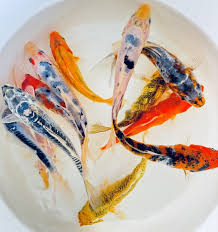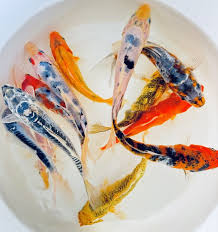Elevate Pet Supply
SELECT STANDARD FIN KOI
SELECT STANDARD FIN KOI
Couldn't load pickup availability
Standard Fin Koi are hardy and beautiful, but they do have some specific care needs to thrive—especially given their size and long lifespan. Here's a breakdown of their essential requirements:
Habitat
- Pond Size: Adult koi need at least 250 gallons per fish. A small group may require 1,000+ gallons.
- Depth: Minimum of 3 feet, ideally up to 6 feet to protect against predators and freezing.
- Filtration: A powerful filter that can cycle the pond volume 3–5 times per hour is crucial.
- Shade & Protection: Partial shade helps prevent overheating, and netting or barriers can deter predators.
Water Quality
- Temperature: 64–75°F (18–24°C) is ideal.
- pH: Maintain between 7.0 and 8.6.
- Oxygen: Ensure at least 6 mg/L of dissolved oxygen.
- Ammonia/Nitrite: Keep as close to 0 ppm as possible with regular testing and water changes.
Diet
- Omnivorous: Feed a mix of high-quality koi pellets, vegetables (like peas or lettuce), and occasional protein treats like shrimp.
- Feeding Frequency: 1–2 times daily in warm months; reduce or stop feeding below 50°F (10°C) as their metabolism slows.
Maintenance
- Water Testing: Weekly checks for ammonia, nitrite, nitrate, pH, and temperature.
- Partial Water Changes: 10–20% weekly or biweekly, depending on stocking and filtration.
- Seasonal Care: In colder climates, koi can overwinter under ice if the pond is deep enough and oxygenated.
Social & Health Notes
- Companionship: Koi are social and do well in groups.
- Quarantine New Fish: Always isolate new arrivals for 2–4 weeks before introducing them to the main pond.
- Lifespan: With proper care, they can live 30–50 years or more.
Given your experience with goldfish and aquatic setups, you might find koi care both familiar and rewarding—just on a larger scale.
Koi are masters at hiding illness until it’s advanced. Here are some key signs that your koi might be unwell or in need of a dietary adjustment:
Signs of Poor Health
- Lethargy or Isolation: If a koi is sluggish, hovering near the bottom, or separating from the group, it could signal stress or illness.
- Flashing or Rubbing: Scraping against surfaces may indicate parasites like flukes or anchor worms.
- Visible Lesions or Ulcers: Red spots, open sores, or raised scales (dropsy) are red flags for bacterial infections.
- White Spots or Mucus: Could be signs of Ich or other parasitic infections.
- Loss of Appetite: A koi that suddenly stops eating may be dealing with internal issues or poor water quality.
Signs They Need a Diet Change
- Stunted Growth: If your koi aren’t growing as expected, they may lack sufficient protein or essential nutrients.
- Dull or Faded Colors: Vibrancy is often tied to diet—especially carotenoids and spirulina for reds and oranges.
- Sluggish Behavior: Low energy can result from poor-quality food or insufficient feeding frequency.
- Irregular Feeding Patterns: If they’re spitting out food or showing disinterest, it might be time to switch brands or formulas.
- Poor Pond Health: Excess waste or cloudy water can indicate overfeeding or low-quality food that’s not being digested well.
Since you’re already well-versed in goldfish care, you’ll recognize that koi are similar—but their size and longevity make early detection even more important.
Water quality and environment are absolutely foundational to koi health—think of them as the immune system your fish swim through every day. When either is off, koi become vulnerable to stress, disease, and even death. Here's how each factor plays a role:
Water Quality: The Invisible Lifeline
- Ammonia & Nitrite: Even trace amounts can burn gills and suppress immunity. Ammonia above 0.25 ppm or nitrite above 0.1 ppm is dangerous.
- pH Swings: Sudden changes (e.g., from 7.5 to 6.0 overnight) can trigger cortisol spikes, weakening the immune system and inviting parasites like Costia.
- Oxygen Levels: Koi need at least 6 mg/L of dissolved oxygen. Warm water holds less oxygen, so summer heatwaves can be deadly without proper aeration.
- Nitrate Buildup: High nitrates (>80 ppm) don’t kill directly but weaken slime coats, making koi prone to ulcers and bacterial infections.
Environmental Factors: The Physical World They Live In
- Overcrowding: Too many koi = more waste = more toxins. It also stresses fish and spreads disease faster.
- Lack of Shade or Shelter: Direct sun can overheat water and fuel algae blooms. Koi also need hiding spots to feel secure.
- Poor Filtration: Without strong mechanical and biological filtration, waste accumulates and beneficial bacteria can’t keep up.
- Seasonal Changes: Rapid temperature shifts or ice cover without aeration can shock koi or suffocate them.
Prevention Is Everything
- Test water weekly for ammonia, nitrite, nitrate, pH, and temperature.
- Use aerators, waterfalls, or air stones to boost oxygen.
- Add aquatic plants to absorb excess nutrients and provide shade.
- Perform regular partial water changes (10–20%) to dilute toxins.
In short, koi don’t just live in water—they live in a dynamic ecosystem. When that system is balanced, they thrive. When it’s off, even slightly, their health can spiral fast.


